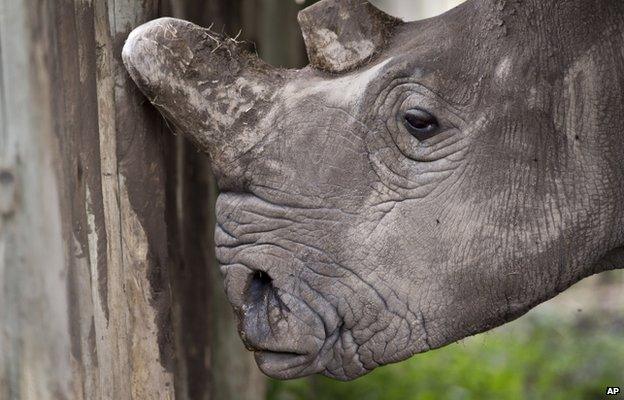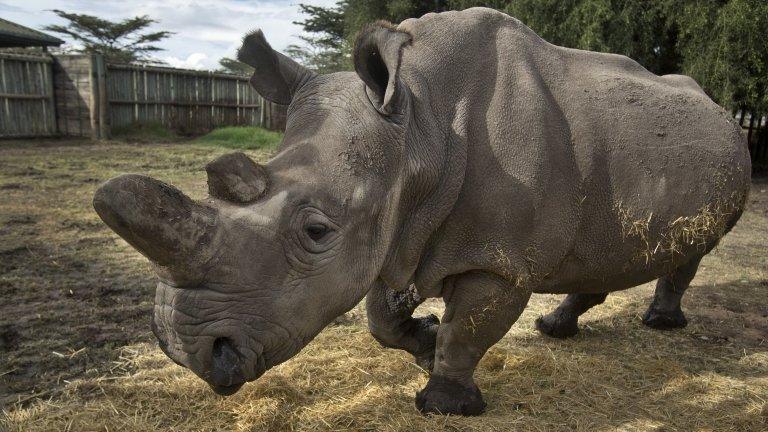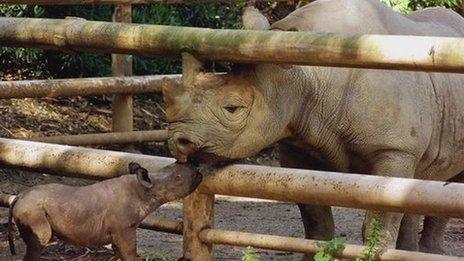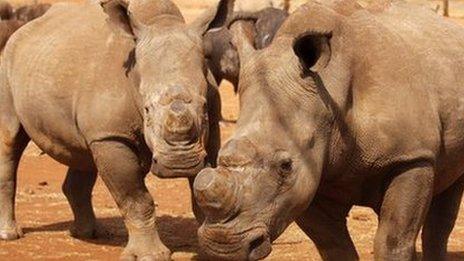Experts on last ditch effort to save endangered rhino
- Published

Only five northern white rhinos remain after poachers hunted them to near extinction
The next few months are critical for the survival of the northern white rhino, as an expert panel races to save it from oblivion.
Some pin hopes on an assisted reproduction programme, but the procedures involved risk harming some of the five animals that remain on Earth.
The rhinos have been hunted to near extinction for their valuable horns.
A 44-year-old male, Angalifu, passed away at the San Diego Zoo this weekend.
This leaves just one male rhino - an elderly bull called Sudan, who lives semi-wild at the Ol Pejeta animal park in Kenya. He is considered incapable of mating naturally.
Jan Stejskal from the Dvur Kralove Zoo in the Czech Republic, which owns the captive rhinos, said specialists would do everything within their power to save the sub-species.
But he told BBC News: "When you have just five remaining specimens, there are many opinions on what should be done with them. There are different institutions involved."
Dvur Kralove Zoo is home to a 31-year-old female called Nabire. This autumn, the zoo began a project to harvest eggs from her for in vitro fertilisation. This would involve creating a rhino embryo using sperm already banked by the Institute for Wildlife and Zoo Animals Research in Berlin, Germany.
In July 2014, examinations of Nabire showed her uterus was full of small cysts, but her left ovary was functional, allowing eggs to be harvested - in theory.
Using a special crane to keep the animal in position, specialists attempted to drain the cysts on 5 October, with partial success. They ended the procedure after encountering technical issues and out of concern for Nabire's wellbeing. They plan to complete the job soon, but Jan Stejskal sounded a note of caution.

Last of their kind
Angalifu - Male, 44 years old. Died at San Diego Zoo on 14 December
Nola - Female, approx. 40 years old. Lives at the San Diego Zoo. Attempts to mate her with Angalifu failed
Nabire - Female, 31 years old. Born in captivity. Housed at Dvur Kralove Zoo, Czech Republic
Sudan - Male, 43 years old. Lives in semi-wild state at Ol Pejeta Conservancy, Kenya. Captured from the wild at age three. Probably too elderly to mate naturally
Najin - Female, 25 years old. Lives at Ol Pejeta Conservancy. May still be a candidate for artificial insemination, but previous attempts in Czech Republic failed
Fatu - Female, 14 years old. Najin's daughter. Absence of pregnancies has probably rendered her infertile

"We can go for artificial techniques of reproduction, but they can really pose a risk to the animals... You have to sedate them and you have to work inside them, so you have to be very careful," he told BBC News.
"We do it only because they are the last of their kind. You can't just give up."
Randy Rieches, curator at the San Diego Zoo, told the BBC's Newsday programme: "None of the surviving animals are reproductively sound.
"At San Diego Zoo, we have frozen semen and cell lines from the northern white rhinos that have already passed. Hopefully, at some point, we will be at a juncture where we will be able to replicate and reproduce the northern white rhino."
Mr Stejskal emphasises that in vitro fertilisation was just one of the options on the table.
"Yes there is some semen frozen in Berlin that could be used for artificial reproduction, but all the options need to be carefully considered by the committee that oversees the project in Ol Pejeta. A decision will be made in late January or February," he said.

The last calf born in captivity - Fatu - was born in 2000 at the Dvur Kravlove Zoo
The committee consists of representatives from Dvur Kralove Zoo, the Ol Pejeta Conservancy, Flora and Fauna International, the Kenya-based Lewa Wildlife Conservancy, Kenya Wildlife Service among others. Their plan of action will be critical for the survival prospects of the northern white rhino.
But Mr Stejskal said this Autumn had been awful for the animals.
In 2009, the zoo transferred two males and two females to the Ol Pejeta park in the hope that more natural surroundings would encourage them to breed. But on 17 October, one of the males, 34-year-old Suni, died of unknown causes.
"Suni was the main hope for natural breeding because he was much younger than either Angalifu and Sudan. That was the first blow to the reproduction programme," said Jan Stejskal.
Then, experts from Berlin examined the two Kenya-based females - Fatu and Najin - and concluded that it was no longer likely that they could mate or breed naturally.
But Najin, Fatu's mother, may still be a candidate for artificial insemination, despite having problems with her hind legs.
"There is still debate over whether the northern white rhino is a different species to the southern white rhino... the default is that it's a sub-species," said Dr Bob Smith, senior research fellow at the University of Kent.
"If they're not different species, some have argued this is not such a disaster because there are thousands of southern white rhino.
"If you're going to do anything with the northern white rhino... you are probably looking at a high-tech solution. Then there is the question of whether that money would be better spent somewhere else."
Dr Smith said funds for conservation were often better spent protecting animals in the wild. But he added: "Having said that, there are examples where bringing species into captivity has almost certainly saved them - including amphibian species that have been wiped out by disease in the wild."
Follow Paul on Twitter, external.
- Published15 December 2014

- Published10 November 2011

- Published30 October 2011
